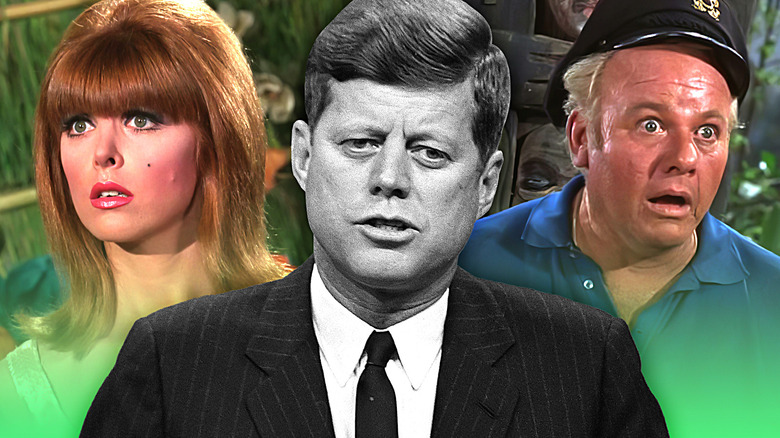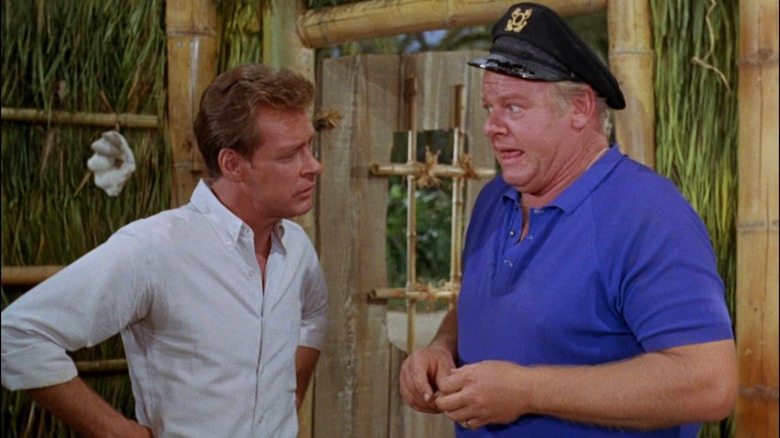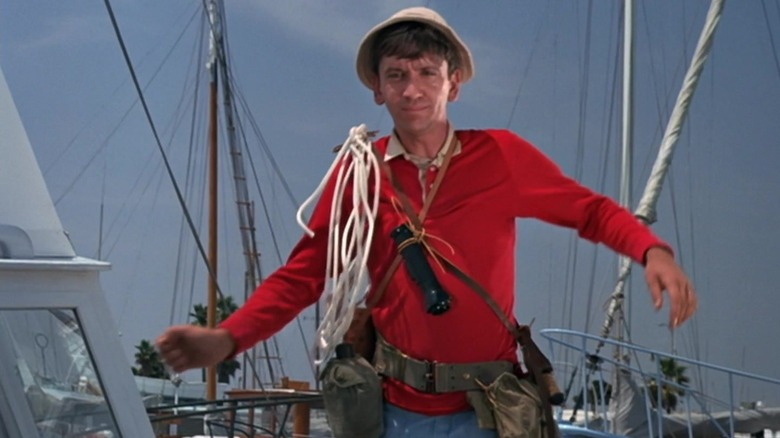Gilligan's Island Was Almost Killed By The Kennedy Assassination
For a sitcom with a premise and characters so basic they could be completely summed up in a minute-long (and absurdly catchy) theme song, "Gilligan's Island" was a real bear to get off the ground.
To start off, creator Sherwood Schwartz was in a world of pain while writing the show's pilot (although that had nothing to do with his creative process and everything to do with the 40-something Schwartz — as 40-something men are wont to do — overestimating his ability to lift stacks of fresh timber unassisted). Then there were the brutal reactions from his agent and network execs, who practically laughed him out of the building when Schwartz proposed a comedy series about seven people being stranded on the same island, week after week. And then there was the pilot shoot in Hawaii, with the showrunner waking up one morning to find himself surveying what appeared to be the aftermath of the climax to Paul Thomas Anderson's "Magnolia," with frogs coming out of his ears.
(That last one's a slight exaggeration, but you get the gist.)
In 1988's "Inside Gilligan's Island: From Creation to Syndication," Schwarz recounted how an even bigger and much more shocking obstacle nearly capsized the series during production on its pilot, "Marooned." Surprise froggy visitors aside, the writer-producer deemed most of the shoot uneventful. "There's no point in detailing the problems involved in the actual filming. One expects the unexpected, and one is never disappointed," as he put it. Murphy's Law, he added, applies doubly to location shooting: "'Whatever can go wrong, will go wrong.' Not once, but two or three times." Of course, that all changed when the second-to-last day of filming rolled around on November 22, 1963, one of the most notorious dates in U.S. history.
'President Kennedy had indeed been shot'
As Schwartz recalled, "Marooned" was scheduled to wrap shooting in Honolulu Harbor on November 23, 1963. "Even though that was our last day of location filming, the scene at Honolulu Harbor was to be the very first sequence in the 'Gilligan's Island' pilot, where the S.S. Minnow leaves on its fateful excursion," he explained. With such a pivotal scene left to finish and the production nearly out of time and money alike, there was little room for error. Then the unthinkable happened.
As production continued in Moloaa Bay on November 22, "somebody came running down to our company on the beach, claiming he had just heard a disc jockey on the radio say that President Kennedy had been shot," Schwartz remembered. And while he and his crew were skeptical at first (being "thousands of miles from the mainland" only made the situation seem that much more implausible, as he explained), "Gradually the realization dawned that this was not simply a rumor. President Kennedy had indeed been shot."
Despite finding it "incredibly difficult to continue work" as the news trickled in that Kennedy had died and Lyndon Johnson had been sworn in as the next U.S. President, Schwartz and his team had little choice but to finish that day's shoot as planned and move on to their hotels in Oahu. However, when they arrived to film in Honolulu Harbor the next day, they learned that it and other U.S. naval and military installations would be shut down for the entire weekend "as a period of mourning for President Kennedy." The problem was, the "Gilligan's Island" cast and crew were already slated to fly back to Los Angeles before things would open up again the following week.
The Gilligan's Island pilot aired 30 years after it was filmed
Local authorities agreed to allow Schwartz to film in Honolulu Harbor on November 25 instead, before pushing it back a day after the 25th was declared "the official day of mourning." But keeping the cast and crew on for an additional two days required a "considerable" amount of money, Schwartz noted, and with the pilot's budget "already overextended" he was trapped between a rock and a hard place. Fortunately for him, producer Hunt Stromberg Jr. and CBS executive Robert Lewine were "delighted" by what they had seen of the episode during filming, so they agreed to covered the extended costs.
No doubt, all involved parties were extra accommodating in light of the unprecedented circumstances. Schwartz himself could vividly remember watching the fallout of the Kennedy assassination from afar:
"It was there, in the lobbies of our hotels in Honolulu, that we watched on live television while the next episode in a violent drama unfolded. We could scarcely believe our eyes as we watched Jack Ruby pump those bullets into Lee Harvey Oswald. Again, the distance from the United States made everything seem more unbelievable, more bizarre."
The surreality of the circumstances is all the more jarring when juxtaposed with the absolute silliness of the "Gilligan's Island" pilot and the series at large. As if all that wasn't enough, "Marooned" wouldn't air for nearly another 30 years after CBS decided to retool the show, only retaining four actors — Bob Denver (Gilligan), Alan Hale Jr. (The Skipper), and Jim Backus and Natalie Schafer (the Howells) — who starred in the episode. Those who keep a sharp eye out may catch that the flags in the background of the scenes shot at Honolulu Harbor are all flying at half-staff — a small, sobering reminder of the terrible events that transpired off-camera.


